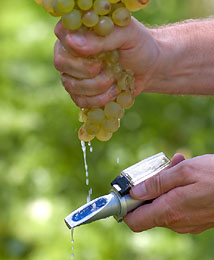 There are many more pieces of homemade wine equipment than can be described in one short post. It is very important to understand the different types of homemade wine equipment, how they function, and whether or not a particular piece of winemaking equipment is needed in your home. Therefore it’s important to introduce to you as many pieces of equipment as possible in as many posts as it takes!
There are many more pieces of homemade wine equipment than can be described in one short post. It is very important to understand the different types of homemade wine equipment, how they function, and whether or not a particular piece of winemaking equipment is needed in your home. Therefore it’s important to introduce to you as many pieces of equipment as possible in as many posts as it takes!
For today’s homemade wine equipment post, you’ll be introduced to three important pieces of equipment: Wine Airlocks, Wine Refractometers, and Wine Filters.
Wine Airlocks:
The first piece of homemade wine equipment today is the airlock. If you’ve done your reading or if you’re already familiar with homemade winemaking, you know that too much oxygen exposure to wine is a bad thing. Too much oxygen can cause oxidation in wine, which effectively ruins it and causes off-flavors and aromas.
One way to combat the over-exposure of oxygen to your homemade wine while it is fermenting is by using a piece of homemade wine equipment called an airlock. Airlocks function is such a way that the CO2 that is produced by the wine yeasts during fermentation is released through the lock, while remaining closed to outside air, preventing oxygen from damaging your fermenting wine. There are many styles of airlocks, designed for varying batch sizes and varying speeds and intensities of fermentation.
Wine Refractometer:
The next piece of homemade wine equipment today is the wine refractometer. This piece of homemade wine equipment is important for those of you home winemakers that plan on using grapes to make your wine. Refractometers are used in the vineyard and are designed to indicate how much sugar is present in the grape.
Functioning similarly to a prism, the wine refractometer separates light into different wavelengths depending upon how much sugar is present in the sample. It works by pressing a sample in between the prism assembly and the daylight plate. When held up toward natural light, the user can peer through the eye piece and view exactly how much sugar is in the sample by reading the marking indicating the Brix % present. It is really quite fascinating! It is important to test multiple grapes and not just one, to get a good average sugar level for the entire batch. Another blog post that explains this in more detail is, How Refractometers Work.
Wine Filters:
The last piece of homemade wine equipment for today is the wine filter. There are varying styles of wine filters, from slower gravity-fed filters to pump-action pressurized filter systems. Wine filters allow you to effectively rid your homemade wine of undesirable matter (i.e. small pieces of fruit, fermentation by-products, dead yeast cells, etc.) and leave a clear, esthetically pleasing beverage.
Stay tuned for more posts describing other important pieces of homemade wine equipment!
———————————————————————————————————
Ed Kraus is a 3rd generation home brewer/winemaker and has been an owner of E. C. Kraus since 1999. He has been helping individuals make better wine and beer for over 25 years.
